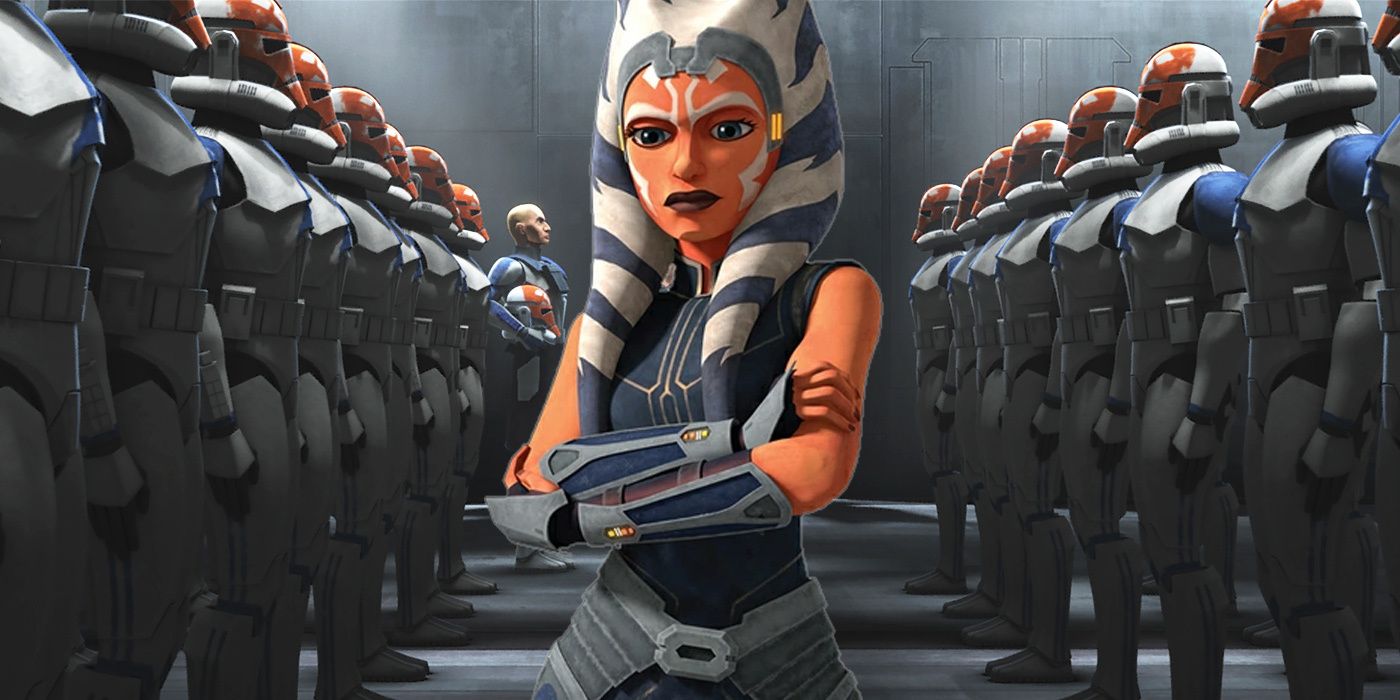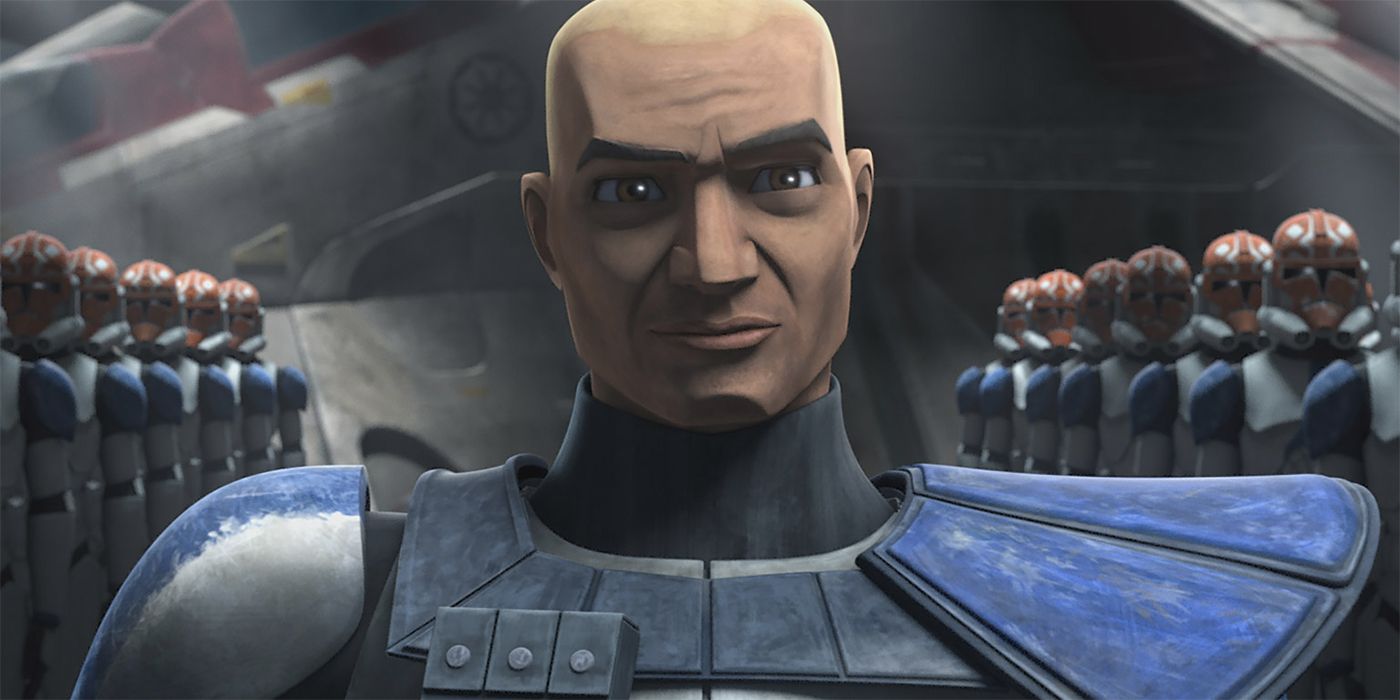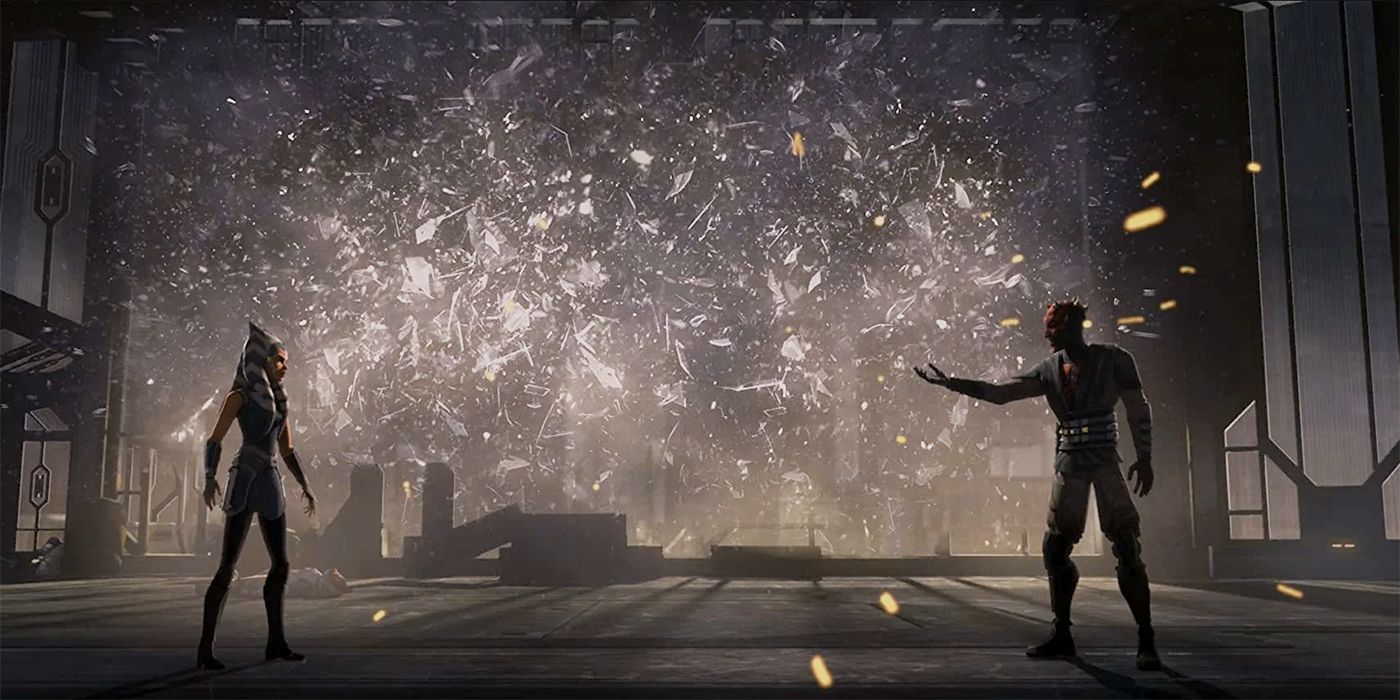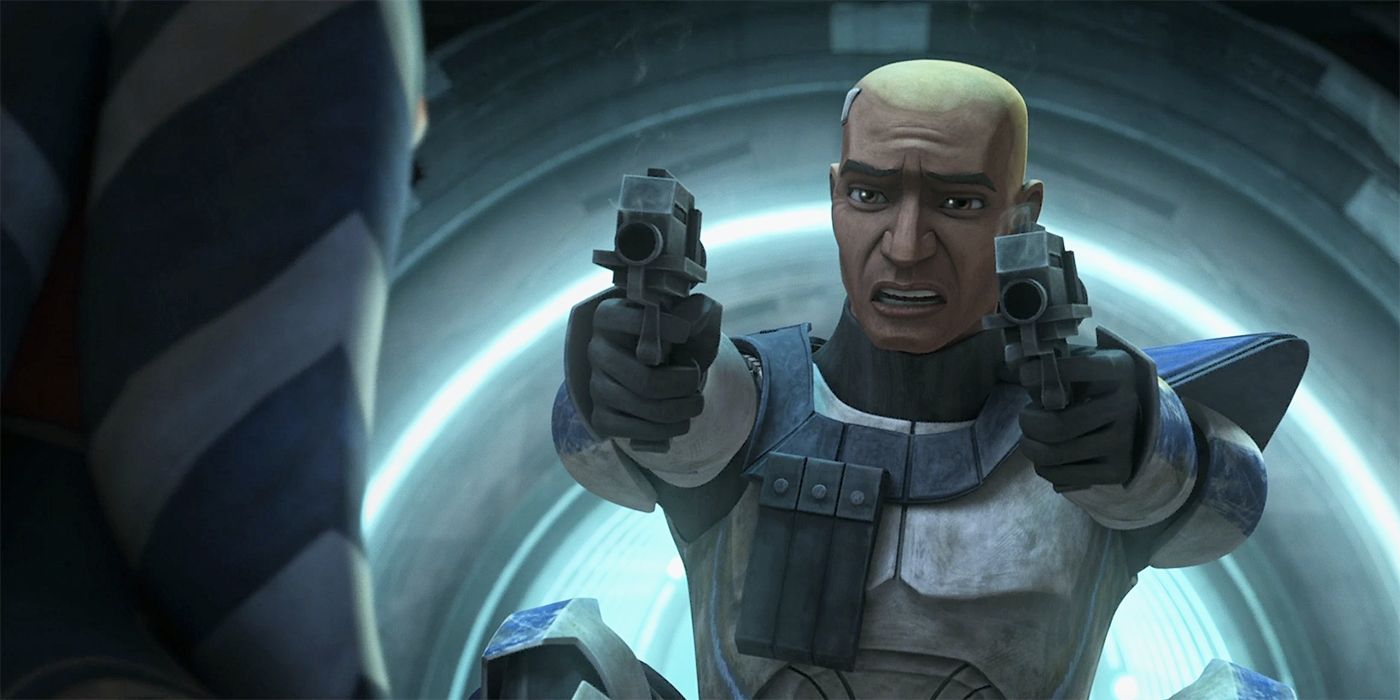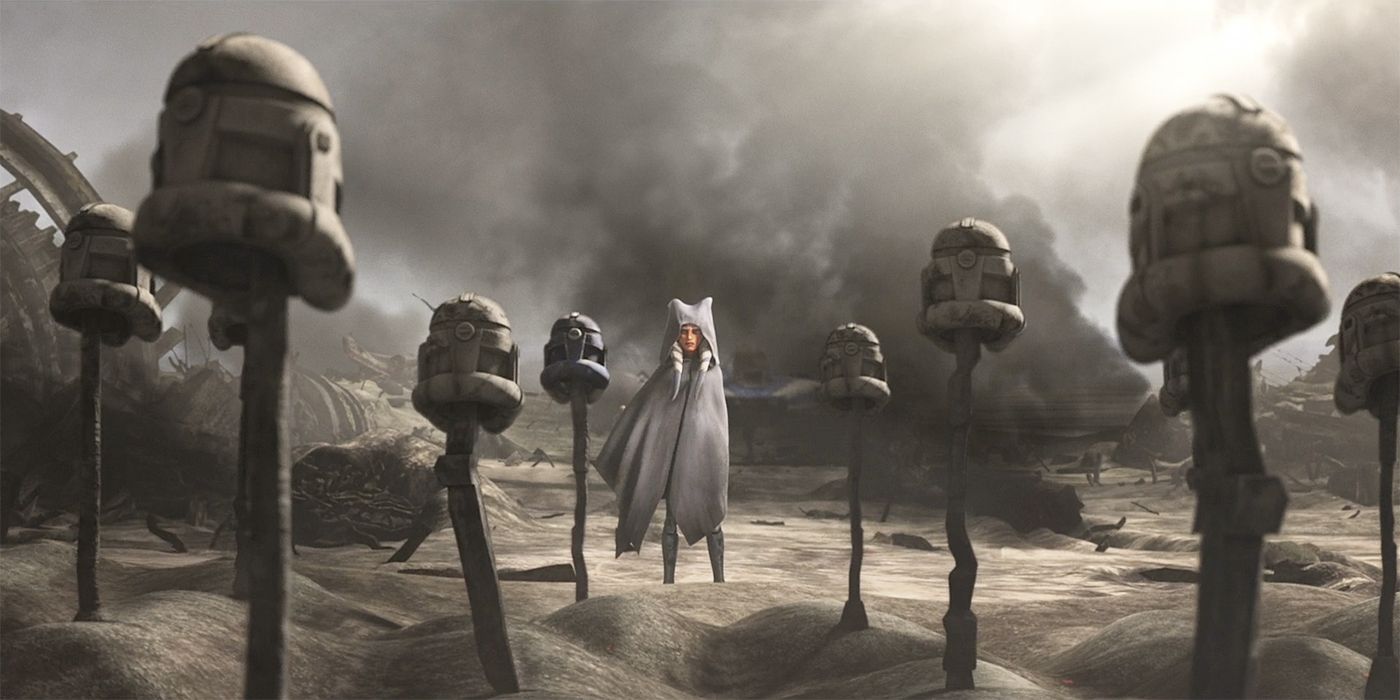The four-episode arc known as “The Siege of Mandalore” serves as both a series finale for The Clone Wars, and a companion piece to Revenge of the Sith. Indeed, this collection of episodes is as cinematic as anything in the Star Wars canon and feels more like a movie than the actual movie/extended pilot that kicked off The Clone Wars did.
After the sort of fanfare typically reserved for Star Wars movies, the first episode, “Old Friends Not Forgotten”, kicks off mid-battle, with Obi Wan (James Arnold Taylor) on the back foot and Anakin (Matt Lanter) arriving to save the day. This is followed by a message from Ahsoka (Ashley Eckstein) and Bo-Katan (Katee Sackhoff), who request Republic assistance in capturing Maul (Sam Witwer) and freeing Mandalore from criminal rule. Of course, all of this so far takes place before the events of Revenge of the Sith, but only just.
Anakin isn’t the only one happy to have Ahsoka back. Upon her arrival, he shows her that Rex (Dee Bradley Baker) and his men have painted their helmets in a touching tribute to their former commander. Before Anakin and Ahsoka can do any catching up, the Jedi are made aware of an attack on Coruscant and Chancellor Palpatine – the very attack that Revenge of the Sith opens with.
Anakin and Ahsoka must part ways once more, as he heads off to rescue the Chancellor, she takes half of the 501st to capture Maul. Ahsoka, Bo Katan and Rex lead a combined force of clones and Mandalorians in a battle sequence with cinematography and choreography that rivals the simultaneous battle happening over Coruscant. The episode ends with Ahsoka coming face-to-face with Maul, who immediately asks why she’s there instead of Obi Wan Kenobi.
For those who’ve wished for an Ahsoka movie, this is it. This is also the best Darth Maul movie, despite the character having shown up in The Phantom Menace and Solo: A Star Wars Story. These are two characters have a good deal in common: both were given in-depth storylines in The Clone Wars (and later Rebels), both were talented apprentices cast out by their masters, and now, both are powerless to stop what is to come. Neither character has come face-to-face, until now.
Across the galaxy, Anakin (Hayden Christensen) has just killed Count Dooku (Christopher Lee), and has been asked to spy on Chancellor Palpatine (Ian McDiarmid) on behalf of the Jedi council. Maul has the general idea of what his former master has been planning, and had hoped to lure Anakin to Mandalore in order to kill him before Sidious could turn him. His grim acceptance of this fact is contrasted with Ahsoka’s stubborn refusal to consider that the Anakin she knew could be vulnerable to the dark side in the way Maul is suggesting.
Aside from the sense of tragedy and foreboding permeating through the second episode in the arc, “The Phantom Apprentice” is gorgeous to watch. The lightsaber battle between Maul and Ahsoka was done with a combination of motion capture and animation that results in one of the best lightsaber fights in the series, animated or live-action. Add that to a truly extraordinary performance by Whitwer, and “The Phantom Apprentice” is a powerful, cinematic experience that elevates the entire arc.
With the next episode, “Shattered”, “The Siege of Mandalore” has reached Anakin’s fall and Order 66. Knowing what’s coming, in this case, doesn’t make the episode any less riveting; on the contrary, it’s devastating to watch Rex and Ahsoka reflect on their time together, knowing that he’ll be forced to try to kill her in a brief amount of time. Order 66 is one of the most heartbreaking sequences in Revenge of the Sith, but “Shattered” tops that drama by making it all the more personal. Watching the clone army turn against Jedi across the galaxy is sad, but watching Rex fight to control himself as he turns on Ahsoka is something much more for how personal it is.
The cinematic scope of “The Siege of Mandalore” is partially due to the writing, the music, and the visuals. But the emotional impact is what makes the whole thing sing. This is the advantage of it being a series finale. Watching the clones turn on the Jedi in Revenge of the Sith is sad, but we don’t really know most of the people we see during the montage covering Order 66. We know Ahsoka, and we know Rex. We’ve spent seven seasons worth of television with them, making this side of events leave us that much more… well, shattered.
The Clone Wars was devised as a way to explore the time between Attack of the Clones and Revenge of the Sith, so, while it didn’t need to end here, the Season 7 finale feels more complete than the (excellent) Season 6 finale did.
At the beginning of the end, “Victory and Death” picks up right where “Shattered” left off. The war is lost; now all that’s left is for Rex and Ahsoka to survive what’s next. How will Ahsoka Tano, Anakin Skywalker’s padawan that The Clone Wars movie introduced all those years ago, fare in the aftermath of his destruction of the Republic they’ve spent years fighting for?
“Victory and Death” isn’t climactic in the way we’re used to; it doesn’t offer a battle with an unknown outcome. As we watch, we know there’s no chance of the Republic being saved. We know Maul, Ahsoka, and Rex will survive. What we don’t know is how that will happen, and in the process of showing us, the episode stays true to the characters and offers a finale that is both action-packed and subdued in its melancholy.
In a great scene, Rex and Ahsoka contemplate how they will get past the army of clones intent on carrying out Sidious’s orders and killing any friend of the Jedi or the Republic. Rex seems to be preparing himself to face the concept of killing his brothers, but Ahsoka, as always, stays true to who she is. She removes Rex’s helmet to reveal his tear-stained face, and the two agree to escape using non-lethal means.
This is in keeping with what we’ve come to know about Ahsoka. Maul’s escape is in keeping with what we know about him, as he selfishly boards an escape shuttle and kills any clones that try to get in his way. The whole episode takes place on the Republic ship crash landing onto a moon, and the feel of this ending has a similar downward momentum (not in a bad way, either). The story is over, really, and now it’s just about sticking the (crash) landing.
Rex and Ahsoka are the only two survivors of the crash, and they create a touching memorial for the fallen out of the helmets, so recently painted in Ahsoka’s honor. A cloaked and grieving Ahsoka lets the sabers kept safe by Anakin – her former master, brother, role model, and friend – fall to the ground in front of the empty helmets. Then, an undisclosed amount of time passes, and we return to the now snow-covered planet. The tell-tale sound of Vader’s breathing apparatus signals his arrival before he’s visible on-screen, as he and his forces survey the crash site.
Vader picks up one of the fallen sabers, his expression unreadable underneath his mask. He ignites the brilliant blue he’d created as a token of affection for his padawan, as an owl (Ahsoka’s symbol from Rebels) circles overhead. Revenge of the Sith showed Anakin losing his loved ones one-by-one; first Padmé (Natalie Portman), then Obi Wan (Ewan McGregor). The final act of "The Siege of Mandalore" finally gives fans a meaningful glimpse at Vader’s deeply-buried grief over having lost Ahsoka as well, the spunky padawan from The Clone Wars movie that finally got the feature she deserved in the form of "The Siege of Mandalore."

